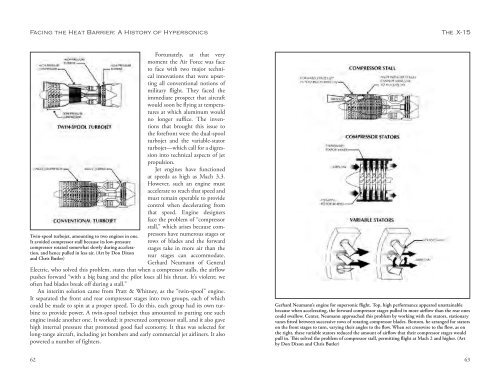Facing the Heat Barrier - NASA's History Office
Facing the Heat Barrier - NASA's History Office
Facing the Heat Barrier - NASA's History Office
You also want an ePaper? Increase the reach of your titles
YUMPU automatically turns print PDFs into web optimized ePapers that Google loves.
<strong>Facing</strong> <strong>the</strong> <strong>Heat</strong> <strong>Barrier</strong>: A <strong>History</strong> of Hypersonics<br />
Twin-spool turbojet, amounting to two engines in one.<br />
It avoided compressor stall because its low-pressure<br />
compressor rotated somewhat slowly during acceleration,<br />
and hence pulled in less air. (Art by Don Dixon<br />
and Chris Butler)<br />
62<br />
Fortunately, at that very<br />
moment <strong>the</strong> Air Force was face<br />
to face with two major technical<br />
innovations that were upsetting<br />
all conventional notions of<br />
military flight. They faced <strong>the</strong><br />
immediate prospect that aircraft<br />
would soon be flying at temperatures<br />
at which aluminum would<br />
no longer suffice. The inventions<br />
that brought this issue to<br />
<strong>the</strong> forefront were <strong>the</strong> dual-spool<br />
turbojet and <strong>the</strong> variable-stator<br />
turbojet—which call for a digression<br />
into technical aspects of jet<br />
propulsion.<br />
Jet engines have functioned<br />
at speeds as high as Mach 3.3.<br />
However, such an engine must<br />
accelerate to reach that speed and<br />
must remain operable to provide<br />
control when decelerating from<br />
that speed. Engine designers<br />
face <strong>the</strong> problem of “compressor<br />
stall,” which arises because compressors<br />
have numerous stages or<br />
rows of blades and <strong>the</strong> forward<br />
stages take in more air than <strong>the</strong><br />
rear stages can accommodate.<br />
Gerhard Neumann of General<br />
Electric, who solved this problem, states that when a compressor stalls, <strong>the</strong> airflow<br />
pushes forward “with a big bang and <strong>the</strong> pilot loses all his thrust. It’s violent; we<br />
often had blades break off during a stall.”<br />
An interim solution came from Pratt & Whitney, as <strong>the</strong> “twin-spool” engine.<br />
It separated <strong>the</strong> front and rear compressor stages into two groups, each of which<br />
could be made to spin at a proper speed. To do this, each group had its own turbine<br />
to provide power. A twin-spool turbojet thus amounted to putting one such<br />
engine inside ano<strong>the</strong>r one. It worked; it prevented compressor stall, and it also gave<br />
high internal pressure that promoted good fuel economy. It thus was selected for<br />
long-range aircraft, including jet bombers and early commercial jet airliners. It also<br />
powered a number of fighters.<br />
The X-15<br />
Gerhard Neumann’s engine for supersonic flight. Top, high performance appeared unattainable<br />
because when accelerating, <strong>the</strong> forward compressor stages pulled in more airflow than <strong>the</strong> rear ones<br />
could swallow. Center, Neumann approached this problem by working with <strong>the</strong> stators, stationary<br />
vanes fitted between successive rows of rotating compressor blades. Bottom, he arranged for stators<br />
on <strong>the</strong> front stages to turn, varying <strong>the</strong>ir angles to <strong>the</strong> flow. When set crosswise to <strong>the</strong> flow, as on<br />
<strong>the</strong> right, <strong>the</strong>se variable stators reduced <strong>the</strong> amount of airflow that <strong>the</strong>ir compressor stages would<br />
pull in. This solved <strong>the</strong> problem of compressor stall, permitting flight at Mach 2 and higher. (Art<br />
by Don Dixon and Chris Butler)<br />
63
















